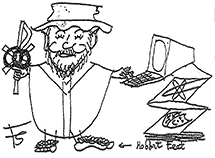We have a local man of otherwise exemplary life, who when asked the population of the village, began enumerating from memory the inhabitants of every house, street by street! As I said to an enthusiastic fellow preacher once, “You are not economical in how you spend other people’s time!”
“The long way around Paddy’s barn” is the long way of telling a short story. Perhaps Paddy, as the stage Irishman, is given to “making a short story long.” That’s what many speakers are accused of doing; also, many preachers - I wonder why? Well, we have a group that meets to discuss the relation of religion and science, and some of the literature - and some of our own discussion - seems to make a short explanation unnecessarily long.
For example, we have been looking at an scholarly journal, “Zygon,” which has been published for forty years by the Institute on Religion in an Age of Science, an affiliate society of the American Association for the Advancement of Science. The contributors to this journal are serious scientists holding serious positions in various disciplines as well as respected theologians and interdisciplinary thinkers.
The particular issue of the journal we have been studying has different sections in each of which several articles have been contributed. The section we first looked at was called Quantum Reality and the Consciousness of the Universe. It has a main article, by a professor of Physical Chemistry; then three responses from scholars, and then three responses to the responses by the first writer. That is reasonably thorough.
What the first writer says, in my summary, concerns the “virtual” part of quantum reality - reality below the level of the atom, of finer detail than, for example, Issac Newton’s understanding of physics (gravity etc.). This “virtual” reality is nonetheless part of reality (not just numbers and ideas) and it seems that matter has something like consciousness. Thus opens up, within physics, the depth of change to more complex forms of life. So the writer argues that the universe has some kind of guiding ”consciousness” and that this opinion is arrived at by valid science.
We have already just got around the first wall of Paddy’s barn!
The next section is the work of Henry Stapp, a theoretical physicist. He says that the fine detail of quantum physics reveals that there is a true element of freedom for individuals to make real choices that are not just products of brain cells, but individuals can direct the action of brain cells, and that therefore there is a scientific understanding of the freedom which allows us to make moral choices. It is an argument against “materialism,” which takes the view that everything we think or do is the necessary product of our cells and atoms, and nothing more.
COMMENT - FROM A FRIEND
I loved the tour round Paddy’s Barn. The summary of the complex scientific arguments and their rational was a “tour de force”! I also liked the level, matter-of-fact tone and (almost) straight sequential argument — apart from a few necessary turns round the corners of the barn: the tone added to the down to earth claim that this seemingly abstruse stuff is really the nuts and bolts of being aware of the present state of science and not allowing ourselves to be bullied out of our faith and also our common sense by those who claim expert knowledge, as in Steve Paikin’s TVO week on faith and science. For some of us, anyway, this article can also serve as a springboard for the religious imagination, as science has always served some religious imaginations throughout the ages. (Ask me about the study of optics in the 12th century.)
LENT 5, (as I, Graham, stagger on the journey, )
We used to call this Passion Sunday, and the tones and spectacles of worship became more solemn. Whatever the experts say who call next Sunday “of the Passion,” whereas we all think of it as Palm Sunday, - carrying palms is what pilgrims, palmers, do - we can increase our sense of pilgrimage with Jesus towards the passion (suffering) and the Cross. Jesus’ passion may seem a “long way around Jerusalem”: let us ask: what is our pilgrimage, how is it passionate?
I heard a good song on the radio about “walking my road, the road I always walk, and it is a road of broken dreams on the boulevard” Good poetry for our souls. Julie Kirkpatrick of Millbrook, Ontario, writing in her journal of walking the St James of Compostello Road, writes of the 23rd Psalm.* She can’t quite take “Lord,” which is patriarchal and hierarchic, but she experiences the need for a Shepherd. She would rather call the Shepherd she experiences the “Light”. She experiences being shepherded, but cannot think of the Shepherd as “who”. Fair enough, for her, but the people she meets and talks about, the ones she corresponds with are “who’s.” The person I focus on in Passiontide and Holy Week is a “who” , referred to in the creed of Nicaea as “Light of Light.” She describes her passion at one stage of her journey: “It doesn’t even matter what you are walking towards anymore. It is simply the act and pain of moving in one direction for a very long time.” We connect with that!
And we keep on walking - with a “who.”
*The Camino Letters, Pyxsis Press, MIllbrook Ontario, 2010.

